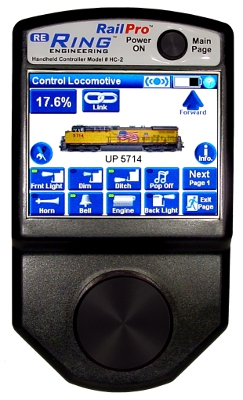Made the plunge. Bought a Rail Pro controller and a few decoders. The LK&O is now officially a Rail Pro railroad.
For fellow model railroaders you know Ring Engineering is a competing system to the industry standard DCC. There is a bit of risk in choosing Ring, a proprietary system, over one of the many DCC systems. However, in light of Rail Pro’s advanced functionality, unavailable in DCC, I believe it is a risk worth taking.
For my non-model railroader readers, Rail Pro is a microprocessor powered radio control on steroids! The handheld controller (left) sends control signals via radio to the microprocessor inside the locomotives (right). The cool part about Rail Pro, unlike conventional systems, is the locomotive modules report back to the handheld controller. There is 2 way communication, a feedback loop. Not only does the controller know what it instructed the locomotive to do it also knows what the locomotive actually did after receiving the command. This feedback loop allows the controller to adjust additional commands sent to the locomotive to refine its performance.
An excellent example of the feedback loop advantage is demonstrated when multiple locomotives are coupled together pulling a train. Rail Pro is able to monitor the current draw of each locomotive thereby determining how hard each is working relative to the other locomotives. The controller then automatically adjusts the locomotives so that each is pulling equally all the while maintaining the speed you have set with the throttle (big round knob). To do this in Digital Command Control, the overwhelmingly popular control standard in the hobby, you would first have to go through a very laborious process of setting up speed tables for each locomotive. Want to see how ugly this process is? Take a look at the instructions. Rail Pro does this same function automatically with no user setup or intervention. In fact Rail Pro does it better because of much finer granularity – RP with 1024 individual speed steps vs DCC with 128 individual speed steps. All possible because of feedback from the locomotive. Cool, huh?
The above is but one of the many advanced functions Rail Pro offers. To get the whole scoop visit Ring Engineering’s web site: www.ringengineering.com
To get started I need to install a LM-2 module in a locomotive. One of my Atlas Alco S2 locomotives will be my first module install. Wish me luck!



Alan Great website with loads of information. Cheers, Darryl
I took the time to watch the RailPro (Ring Engineering) videos. It looks fantastic. Can you give additional information on your experience with the system. At early glance, I would choose this should I ever replace my EasyDCC system, which I built from a kit way back when it was featured in Model Railroader. The only question that I have at this time is: Have you ever attempted to run a locomotive of yours on a standard DCC layout? They say that this is possible. If you have done this, what is involved?
(I guess that is two questions)
Thanks so much for any info.
Dan, none of my locomotives have ever left my layout. However, I can say with 100% certainty that RailPro equipped locomotives run on DCC layouts. The RailPro forum has many members that run their RailPro locomotives on DCC layouts. Some don’t have a layout of their own and run their RailPro locomotives exclusively on DCC club layouts. There are no modifications to the DCC layout or the RailPro components. It is literally plug-n-play.
So I take it that you are extremely happy with your selection. Do you have the sensitive power issues like DCC, where any bit of dirty track or whatever will interrupt the communication?
With capacitors being added to the mix, this is not really much of a problem now.
I am just interested in your thoughts.
Thanks much. By the way, how did you get so good at all of this stuff anyway?
Dan,
I do not have power issues but not because of RailPro. I gave my best shot at addressing the root of the problem:
1. Every rail, regardless of length, has at least one feeder
2. Frogs are powered
3. Rail joiners are soldered (except module boundaries)
4. Track is laid flat, square, and even
5. Loco wheels contact squarely (flat glass test)
6. Wheels and rails are kept clean and free of oxidation
RailPro does not place the control signal on the rails like DCC therefore it has less communications issues i.e. no runaways, no lost CVs, no slow responses. But good rail to wheel contact is still needed for uninterrupted power to the motor. Keep-alive supercapacitors can mitigate poor power connection to an extent but require installation in every locomotive which raises cost. Fitting keep-alives can also be an issue in small locomotives where space is at a premium.
It is like the old Fram filters slogan – Pay me now or pay me later. I paid up front during construction so I don’t pay later. Should a time come when regular maintenance doesn’t get the job done I have the option of adding keep-alives as needed.
Yes, I am very pleased with RailPro. It performs as advertised.
“Thanks much. By the way, how did you get so good at all of this stuff anyway?” – Life 🙂